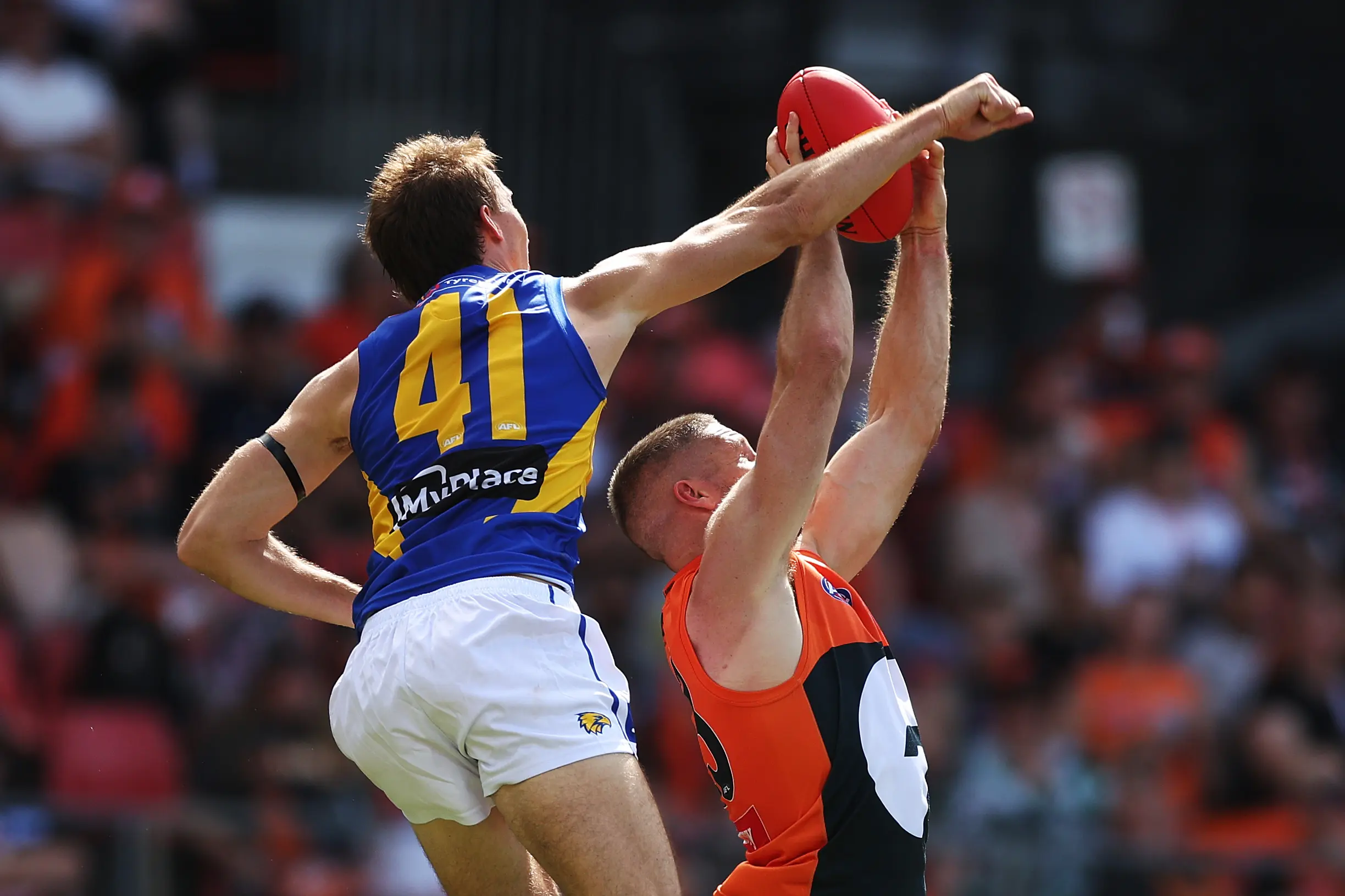With a trip to South Australia due for 16 teams this weekend, seven of this round's nine games will feature at neutral grounds between both sides.
Without the influence of home-ground advantage or a one-sided crowd, Gather Round can produce the purest of football contests as both sides adapt to the irregularly experienced venues of the Adelaide Oval, Barossa Park or Norwood Oval.
It also emphasises the importance of sticking to your game plan and trusting it to work on unfamiliar territory. Certain statistics are a key identifier of whether a club has the game on their terms, and they will be of greater significance this weekend in the City of Churches.
So, let's delve into what your club needs to do to claim success in Gather Round this weekend...
Adelaide vs Geelong
Marks
Due to an ineffective tagging tactic employed by Melbourne in Round 4, the Cats cruised to victory and recorded a near AFL record amount of marks, taking 165 for the match, ranked 12th all-time.
While it's not expected the Crows will accept that kind of freedom, uncontested marks were the key to victory the last time the Cats made the trip to South Australia.
In Geelong's demolition job of the Power in last year's qualifying final, Geelong recorded 108 marks, only 10 of which were contested. The Cats went on to bombard the Power with inside 50 entries and scored 38 times.
If Adelaide is to avoid the same fate, they'll have to continue their ability to restrict opposition marking this season.
Currently, the Crows concede the third-fewest marks per game, whilst averaging the fifth-most themselves. A continuation of that trend will be key to handing Geelong their third loss this season, and amending their tough defeat to the Suns in Round 4.

Collingwood vs Sydney
Inside 50s
Sydney's latest two wins on the trot have come from an uptake in inside 50 entries.
The Swans average 52.5 for the season, which sits around midtable, but their last two performances have seen them record 55 and 57 inside 50s, respectively, both resulting in wins for the 2024 runners-up.
Their opposition, however, has been one of the premier teams at generating scoring opportunities, averaging 56.8 inside 50s per game in their 3-1 start to the season.
It's a curious watch on how the Pies handle the losses of Dan Houston through suspension and Lachie Schultz and Jordan De Goey through injury, as Houston's absence in Opening Round was clear when Collingwood lost deplorably to GWS, while Schultz had just hit his stride.
With Houston averaging 3.3 inside 50s per game and 6.3 score involvements, De Goey averaging four entries and 5.5 score involvements, and Schultz 6.3 score involvements, the Magpies will need alternative avenues to generate scoring opportunities on Friday.

North Melbourne vs Gold Coast
Scores from stoppage
As the two highest scoring sides from centre bounce this season, a juicy midfield match-up awaits in the Barossa Valley.
The Roos average 21.8 points from the centre, while the Suns average 20. From stoppages across the field, Gold Coast are slightly better, averaging 44.3 points compared to North Melbourne's 41.5.
When the Kangaroos failed to make an impact from stoppage last week, they reverted to their old selves, producing just 12 scoring shots from 30 clearances and 37 inside 50s. Meanwhile, Gold Coast's undefeated start to the year has been characterised by unrelenting scoring production from stoppages, with their narrow win over Adelaide suggesting as much, generating 26 scoring shots from 60 inside 50s, despite only recording 35 clearances for the match.
With the likes of Luke Davies-Uniacke and Harry Sheezel, and Matt Rowell and Noah Anderson running around, the midfield battle will be a fascinating watch.

Carlton vs West Coast
Marks inside 50
It was the key for West Coast in Round 4, and it is the key again in Round 5 - the Eagles must limit how many marks inside 50 they concede.
The Eagles allowed 28 against GWS, the most conceded in a game this season, and the 26th-most conceded all time. Had West Coast allowed for one extra mark inside 50 though, they would've jumped to equal 14th.
Destroyed by a tall forward pairing of Jesse Hogan and Aaron Cadman, an inexperienced Eagles side was unable to defend their key position opponents.
Now coming up against another forward line with key forward stars, West Coast must place their attention on limiting Charlie Curnow, Brodie Kemp, Lewis Young and now Harry McKay's influence, who is set to return.
The Blues average just eight marks inside 50 per game this season, although it has largely been due to the quality of their entries rather than the talent inside 50. The trio Carlton ran with last week - Curnow, Kemp, and Young - combined for three of Carlton's measly four marks inside 50. Evidently, they will produce the bulk of these statistics' figures.
It's also apparent that limiting the influence of Carlton's key forwards impacts the Blues' ability to score, as they were unable to crack 50 points last Thursday night.
It should be a straightforward approach by West Coast this week - stop Carlton's ability to mark inside 50, or risk another belting.

Western Bulldogs vs Brisbane
Inside 50s
Inside 50s will be the key at Norwood Oval, the skinniest ground at AFL standard.
Brisbane played at the venue at Gather Round last year and recorded a whopping 71 inside 50s on the narrow turf, piling on 32 scoring shots as a result.
The Lions already average the second most inside 50s this season too, recording nearly 60 per game.
The Bulldogs sit mid-table on the other hand, averaging 53.5 per game, which is a decline from their league-leading season average in 2024 of 56.6 per game.
If the Bulldogs are to beat the undefeated reigning premiers, a slight improvement in attacking efficiency could be a large difference maker in their bid at taking home four premiership points.

Melbourne vs Essendon
Intercept marks
Despite lacking Jake Lever, Melbourne's defence has still been solid at times this season, although not at its clinical best.
However, their ability to intercept kicks down the line or entries inside 50 has remained elite, ranking third for intercept marks per game behind Brisbane and Hawthorn.
With Essendon heading into Gather Round without key forward-line members such as Kyle Langford and Tom Edwards, the Demons have a prime opportunity to dominate defensively and significantly impact Essendon's ability to score.
As an additional confidence booster, the Bombers also already average the fourth-fewest marks inside 50 and contested marks per game.
Essendon will be hoping they can improve their intercept-marking ability too, as their current average suggests Demons forwards Jacob Van Rooyen and Bayley Fritsch could finally overcome a sluggish start to the season.
Essendon averaged just 11.3 intercept marks per game, the fewest in the league, and conceded the third-most marks inside 50 per game. Another dismal defensive display aerially could be the factor that upends their chance at consecutive wins, and allows Melbourne to overcome their winless start.
Richmond vs Fremantle
Scores per inside 50 entry
The Dockers defeated the Bulldogs in Round 4 despite having 19 fewer inside 50 entries, boiling down to their scoring efficiency from the entries they had.
The Dockers scored at a 50 per cent clip, which is the benchmark for the elite clubs in this metric, as the current leaders in season 2025 St Kilda and Adelaide are both generating a scoring shot from every second inside 50.
Round 4's performance was a vast improvement from their current season average of 43.6 per cent, and will be required again to hold off a Richmond side easy to underestimate.
The Tigers are surprisingly a top-four side for scores per inside 50 entry, with a rate of 48 per cent.
However, Richmond averaged the fewest inside 50s per game, meaning they are usually unable to tally a winning score despite their attacking efficiency.
Although, it is why the Tigers have been competitive in a couple of games this year, which means if Richmond can generate a fluent offensive playstyle against Fremantle, they could sneakily find themselves in another competitive contest.
St Kilda vs GWS
Scores per inside 50 entry
Another pair of sides who are strong at converting their inside 50 entries, the sudden rise of St Kilda makes this clash a curious watch.
The Saints currently have the best efficiency in the AFL for scores from inside 50 entries, with a rate of 50.5 per cent, while GWS are also within the top third of clubs, scoring from 47.8 per cent of their entries.
Intriguingly, GWS are one of the best sides in the last line of defence, highlighted by their key talents Sam Taylor and Jack Buckley. Oppositions that have played the Giants this year have converted an average of just 36.6 per cent of their inside 50 entries.
To clarify, that opposition conversion rate against GWS would place a team 17th for scores per inside 50 entry if they continued that trend weekly.
Time will tell if the Saints will continue their high conversion rate, or if the Giants will buck the trend with their stingy defence on Sunday.
Port Adelaide vs Hawthorn
Pressure Acts
The Power's corralling pressure put Hawthorn off a step in their semi-final clash, forcing the Hawks to play at 69.2 per cent disposal efficiency, a dip of five on their 2024 season average.
In a rematch that will undoubtedly have fireworks to begin the game, if the Power can ramp up the pressure on Hawthorn's ball carrier immediately, it may set the tone for a potential upset victory.
Port Adelaide already average the fourth-most pressure acts per game this season which highlights their ability to get rid of their opponent's time and space.
Likewise, Hawthorn has the chance to apply the same pressure onto Port Adelaide and get them on the back pedal to start the match. St Kilda's quickfire beginning to Round 4 saw the Power struggle to get back in the contest, and another strong first quarter from their opponent this week would be deflating.

























